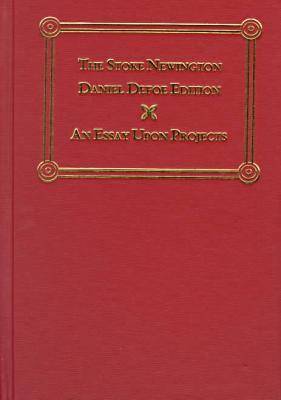AMS Studies in the Eighteenth-Century
1 primary work • 4 total works
Book 56
Defoe's prefatory comments to "An Essay on the History and Reality of Apparitions" (1727) indicate a split between ignorant belief and profane disbelief in spirits in the long eighteenth century, but also establish for the reader the author's intention of reconciling the religious with the supernatural through an argument based in 'solid Foundation'. In this text, Defoe utilizes three criteria - reason, religion, and rhetoric - both to prove the existence of apparitions and to educate his reader in how to distinguish real spirits from tricks of the imagination, folk tales from true accounts of visitations. He draws upon colloquial, historical, and Biblical examples in his demonstrations, and in attempting a reasoned defense of the existence of apparitions, engages the Enlightenment rationality and rhetoric of Thomas Hobbes and Joseph Glanville. Recognized as a statement of Defoe's rational and religious philosophies, "An Essay on the History and Reality of Apparitions" is also regarded by some critics as an important antecedent to the spiritualism of the Gothic novel.
Among the valuable secondary tools included in this edition are critical headnotes that contextualize Defoe's Essay within Biblical Christianity, Puritanism, occult thought, and other spiritual themes of the period. The headnotes also analyze Defoe's wider views on Catholicism, dreams, paganism, and witchcraft, and assess the Essay through consideration of literary topics including humor, rhetoric, and narrative style. Scholars familiar with Defoe's supposed use of pseudonym will find the attributive history of the Essay useful, and the "Bibliography of Works Consulted Before 1731" provides a list of contemporary resources invaluable to any reader studying the Essay, "Defoe's Political History of the Devil" (also published by AMS Press), and other spiritual and philosophical literature of the period. This carefully prepared volume conforms to the highest standards of textual and editorial scholarship and returns a scarcely available title to readers in a definitive edition, essential to any research collection of Defoe's works.
Among the valuable secondary tools included in this edition are critical headnotes that contextualize Defoe's Essay within Biblical Christianity, Puritanism, occult thought, and other spiritual themes of the period. The headnotes also analyze Defoe's wider views on Catholicism, dreams, paganism, and witchcraft, and assess the Essay through consideration of literary topics including humor, rhetoric, and narrative style. Scholars familiar with Defoe's supposed use of pseudonym will find the attributive history of the Essay useful, and the "Bibliography of Works Consulted Before 1731" provides a list of contemporary resources invaluable to any reader studying the Essay, "Defoe's Political History of the Devil" (also published by AMS Press), and other spiritual and philosophical literature of the period. This carefully prepared volume conforms to the highest standards of textual and editorial scholarship and returns a scarcely available title to readers in a definitive edition, essential to any research collection of Defoe's works.
The ""Essay upon Projects"" was written during the years immediately following two of Defoe's serious brushed with the law. In 1692, #17,000 in debt, he was declared bankrupt. After a brief imprisonment and during the time he subsequently spent hiding from authorities and creditors, he began work on various ""projects"" which he thought would make England a better nation and, were they approved and acted upon by the government, bring him fame and fortune. Composed piecemeal, the ""Essay"" offers a wide ranging series of proposals for radical social reform, while attempting to gain some dignity for what Defoe called, in another context, the despicable art of projecting. Among Defoe's schemes, predictable enough, was a project for the reform of his nation's bankruptcy laws, a project over which Defoe, in his own words, ""waxed hot"". Five years after he began it, Defoe published the work. By 1697, he had righted himself publicly and financially, having served as Accomptant to the Commissioners of the Glass Duty in King William's government and having profited from his brick and tile factory in Tilbury. The work represents new beginnings for Defoe as a political and literary figure, new assertions of principles, new ventures on public terrain. At its most utopian, it was an effort at charting a new future for England - a combination of social engineering and economic scheming. It is a commonplace to say of science fiction that while purporting to be about other worlds and often about future time, it is invariable about our present life on earth. Similarly, it may be said of ""An Essay upon Projects"" that although Defoe's work treated future projects and possibilities, they were very much rooted in the events of the recent past and the present. Read against the swarm of proposals published during the 1690s (usually in pamphlet form), the text seems thoroughly rooted in the efforts at attempting to solve the economic problems of the late-17th century. On the other hand, Defoe enjoyed assuming the role of a prophet, and if some of his schemes seemed to foreshadow his future developments, whether in his time or ours, he would hardly have been reluctant to take credit for his ingenuity and farsightedness.
First published in 1726, this full-length study of the devil's role in society combines Biblical history with common sense as Defoe considers the conflict between forces of destructive evil and the benevolent Deity which controls the world.
v. 39
The Consolidator is at once early science fiction in the form of an early voyage to the moon, a satire on the moral and intellectual currents of the time, a tongue-in-cheek praise of China's contribution to world knowledge, and a Whiggish version of the historical events of the previous 45 years.


